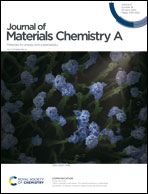The degradation mechanism of vanadium oxide-based aqueous zinc-ion batteries†
Abstract
Aqueous rechargeable zinc-ion batteries (ARZIBs) have recently become a hot topic due to their low cost and high safety. The current research is mainly focused on developing advanced cathode materials that have demonstrated satisfactory electrochemical performances with high capacity and rate capability. However, two prevalent problems are widely encountered: byproduct formation and poor cycling performance at low current densities. The influence of the byproduct and degradation mechanism is complex but is rarely investigated. Here, we have reported a comprehensive study of the current density-dependent cycling stability of vanadium oxide-based ARZIBs. The basic zinc salt (BZS, namely, the byproduct) is universally detected on both the cathode and anode surfaces. The generation of BZS originates from the chemisorption of zinc hydrated ions and it precipitates as zinc-based hydroxyl complexes, while its appearance/disappearance is strongly associated with the applied current. The nucleation of BZS is spontaneous and related to the surface state of the materials. Upon applying a small current, a large amount of BZS irreversibly aggregates and blocks the ion transport in the following charge/discharge processes, leading to quick capacity loss. Vanadium dissolution in an aqueous electrolyte is observed accompanied with the BZS formation and is deemed as another vital issue causing the performance degradation. This work specifies the relationship between the cycling stability and the byproduct as well as the formation mechanism of BZS, both of which can provide a useful background for exploring high-performance ARZIBs.



 Please wait while we load your content...
Please wait while we load your content...